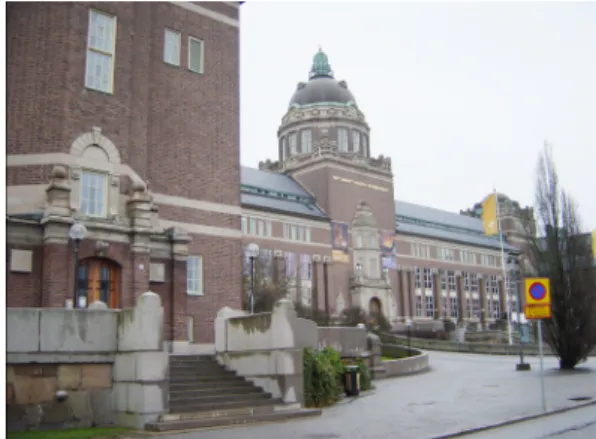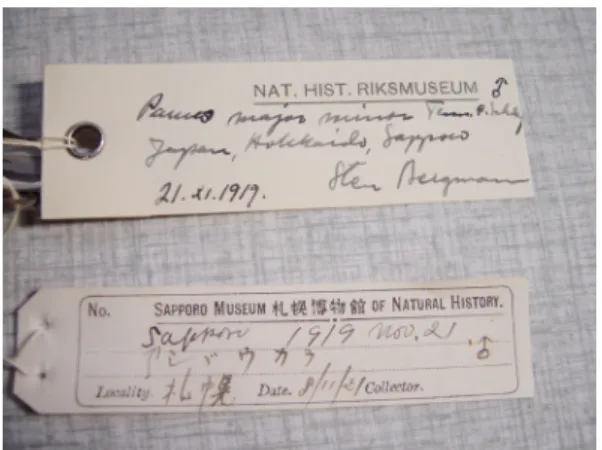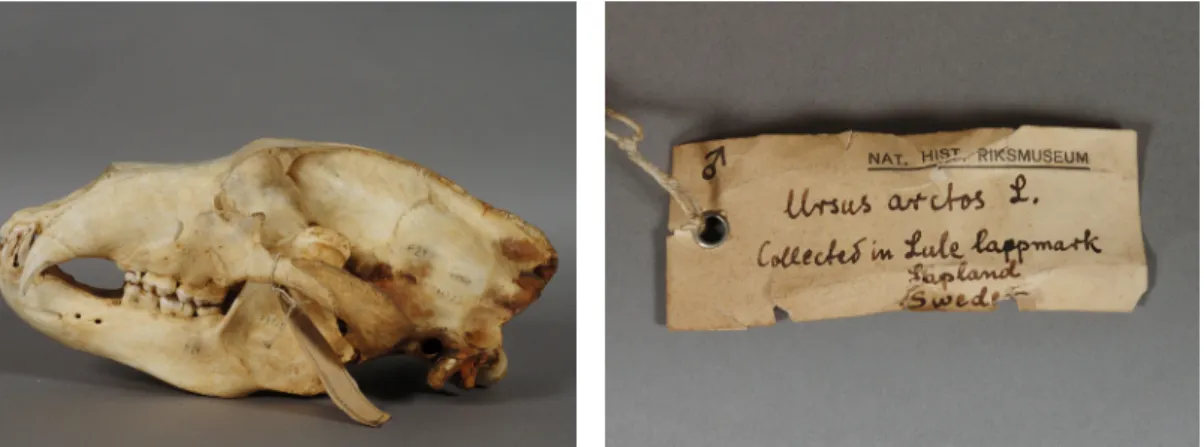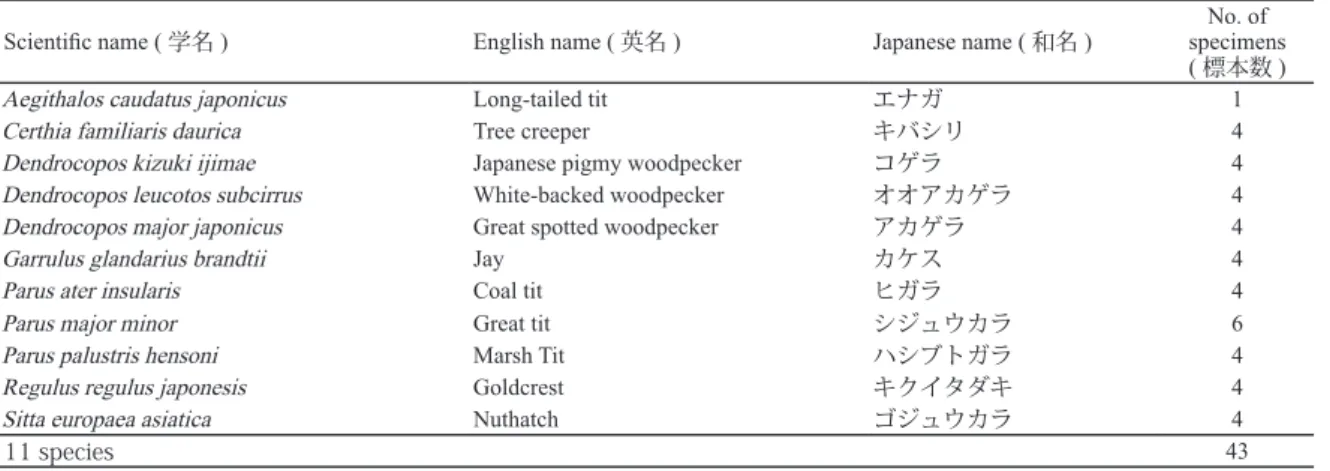Instructions for use
Saburo Hatta
Author(s)
Masuda, Ryuichi; Sato, Takehiro; Grönwall, Olavi; Kato,
Masaru
Citation
北大植物園研究紀要 = Bulletin of Botanic Garden, Hokkaido
University, 8: 1-13
Issue Date
2008-09
DOI
Doc URL
http://hdl.handle.net/2115/34666
Right
Type
bulletin
Additional
Information
File
Information
p1-13.pdf
i Creative Research Initiative “Sousei”, Hokkaido University, 060-0810 Sapporo, Japan ii Graduate School of Science, Hokkaido University, 060-0810 Sapporo, Japan
iii Department of Vertebrates, Swedish Museum of Natural History, SE-104 05 Stockholm, Sweden
iv Botanic Garden, Field Science Center for Northern Biosphere, Hokkaido University, 060-0003 Sapporo, Japan
Bergman’s collection and a specimen gifted from Professor Saburo Hatta
Ryuichi Masuda
i,ii, Takehiro Sato
ii, Olavi Grönwall
iii, and Masaru Kato
ivIntroduction
In this paper, we report the specimens of birds and mammals originating from Hokkaido University, which are currently preserved in the Swedish Museum of Natural History. In addition, we discuss the process of transportation and historical values on the specimens.
We currently study zoogeographical history of mammalian fauna of the Hokkaido Island, Japan. When considering how animals immigrated and fauna has been established on Hokkaido, it is essential to include zoogeography on the Kuril Islands and Kamchatka Peninsula. Around 1930 when the Kuril Islands were in the Japanese territories, a Swedish naturalist, Mr. Sten Bergman, had his expedition on the islands, and then collected various kinds of animals there. At present, the animal specimens collected by Mr. Bergman are very important materials for studies of zoogeography and natural history of the areas. Therefore, we have thought that it was necessary to survey and analyze the animal specimens of Bergman’s collection.
Bergman (1948) described in his book that he sent animal specimens to Sweden during his expedition to the Kuril Islands. In addition, in this book he mentioned that he visited Professor Tetsuo Inukai of the Hokkaido University Natural History Museum (HUNHM) at Sapporo in 1930 and exchanged his bird specimens for specimens of Professor Inukai. Actually the bird specimens gifted from Bergman are still preserved in good conditions at HUNHM. The rest of Bergman’s collection is housed in the Swedish Museum of Natural History (NRM), and includes specimens that he collected during expeditions in the Kuril Islands, Kamchatka Peninsula, Korean Peninsula, and New Guinea. Therefore, we started examination of animal specimens of Bergman’s collection at NRM.
Swedish Museum of Natural History (NRM)
Two of the authors (Masuda and Sato) visited NRM (Fig. 1) in December, 2007. This museum is located at northern Stockholm and next to the campus of Stockholm University.
The NRM was founded by the Royal Swedish Academy of Sciences in 1819, but the collections dates back to 1739 when the Royal Academy was founded. This museum has been independent from the Royal Swedish Academy since 1965.
The general exhibition includes areas of geology, zoology, botany, and the natural environment. About 700,000 people visit the exhibitions every year. When the two authors visited the museum, the special exhibition “From Linneaus to DNA” was held, where the Linneaus’ contribution to taxonomy and the history of taxonomy were shown. Professor Carl von Linné (Swedish name of Linnaeus: 1707-1778) was a Swedish medical doctor and taxonomist who established the binomial nomenclature of scientific names of organisms. This museum was visited by the Emperor and Empress of Japan in May, 2007.
The NRM has about 250 staff members and high research activities, in addition to education of natural history to citizens. There are six research divisions: Botany, Zoology, Paleontology, Geology, Contaminated Environments, and
Molecular Systematics. The Zoology Division has three departments; Departments of Vertebrate Zoology, Invertebrate Zoology, and Entomology. In the Department of Vertebrate Zoology, the researchers study natural history of mammals, birds, fishes, amphibians, and reptiles. The website of NRM is available: www.nrm.se.
Sten Bergman as naturalist
Sten Bergman (1895-1975) is a well-known adventurer and naturalist of Sweden. He was an associated researcher at the department of Vertebrate Zoology and employed as deputy for shorter periods during several years. Otherwise he earned his living through lectures about his journeys. The NRM keeps his portrait in oil by Finnish-Swedish artist Johannes Snellman (Fig. 2). In addition to the Kuril Islands, he made expeditions in the Kamchatka Peninsula (Bergman, 1923, 1924), Korean Peninsula (Bergman, 1937), and New Guinea (Bergman, 1950, 1954, 1959, 1968), and his travel reports was published as books in Swedish. The expedition book of the Kamchatka Peninsula was translated to Japanese. To our knowledge, expedition books of the Korean Peninsula and New Guinea have not been translated to Japanese. In each book, Bergman described details on natural environments, fauna, flora, and manners and customs of the native people. Especially, he was very interested in collecting birds and made stuffed specimens. His bird collections from New Guinea and East Asia to the Kamchatka Peninsula is large and has a great ornithological importance.
Hokkaido University Natural History Museum (HUNHM)
The HUNHM originated from the Museum of Kaitakushi (former government of Hokkaido). In 1882, the new building of the museum was build at the center of Sapporo City, and it is currently used for the exhibition corner of the Botanic Garden of University. In 1884, the museum was transferred to the Sapporo Agricultural College which developed to Hokkaido University (Fig. 3).
During the period of the Museum of Kaitakushi, they concentrated on collecting materials of industries and cultures. After it was transferred to the Sapporo Agricultural College, Directors Saburo Hatta, Tetsuo Inukai, and Hisashi Abe made efforts at collecting animal specimens. Especially, the specimen collection including more than 10,000 birds is one of the largest ornithological collections in Japan. The specimens have been collected as follows. Mr. Shojiro Murata collected bird specimens from Hokkaido and Sakhalin from 1890 to 1910 (Karafuto-cho, 1914; Murata, 1900a, 1900b, 1901a, 1901b, 1902; Hatta and Murata, 1905). The bird collection of Captain Thomas Blakiston (an English naturalist who stayed at Hakodate, southern Hokkaido) was transferred from the Museum of Hakodate in 1908 (Kato and Ichikawa, 2002). Specimen exchanges with the American Natural History Museum and the Smithsonian Institution were actively done (Kato and Ichikawa, 2004). Specimen collections from Taiwan and Southeast Asia were also made (Hokkaido University, 1926). Moreover, there have been many donations of additional specimens collected within Japan.
There are currently three staff members in HUNHM, who work on researches and supporting activities. In 1920’s, this museum had the second most visitors of the Japanese museums (Hokkaido University, 1926). The reason why Bergman visited this museum and exchanged the bird specimens with those of this museum is likely that his expedition was done on the Kuril Islands near Hokkaido, and that Inukai as famous zoologist was working at this museum. In addition, another probable reason is that this museum had established a nice collection of bird specimens.
Bergman’s collection and stuffed specimens of birds collected on the Hokkaido and Kuril Islands
Of Bergman’s collection preserved at NRM, more than 900 specimens were collected on the Kuril Islands. They are currently preserved in wooden shelves and are still in good conditions as scientific specimens. In addition, there are 50 bird specimens (comprising 14 species) from Hokkaido. All of them were small birds that Bergman received from Professor Inukai
(Director of HUNHM at that time) when he visited Sapporo in 1930, in exchange for specimens collected on the Kuril Islands. The species and numbers of the specimens from HUNHM are shown in Table 1. The specimens are found to be preserved in good conditions (Fig. 4a). Each of them has specimen labels (described in Japanese) of HUNHM as well as those of NRM (Fig. 4b). On the latter ones, signatures ink-written by Bergman were seen. Because in Hokkaido University there are no records on the species and numbers of specimens given to Bergman, information of bird specimens found at NRM is very important for historical study between the two museums.
In addition, HUNHM preserves the specimens that were given from Bergman (Fig. 5a). They are all stuffed specimens of small birds that were collected on the Kunashiri Island (southern Kuril Islands) and have specimen labels where the name of “Sten Bergman” was specially printed (Fig. 5b). They are 43 specimens comprising 11 species (Table 2). The labels show that they were collected on the Kunashiri Island between 1929 and 1930. Ten of the 11 species given by Bergman to Professor Inukai, were also among 14 species given back by Professor Inukai in return. Only one species, a marsh tit (Parus palustris hensoi) in Bergman’s collection was exchanged for a different species in HUNHM; a willow tit (P. montanus restrictus) (Tables 1 and 2). However, because the marsh tit is morphologically very similar to the willow tit, a re-examination of the two specimens is warranted. The high number of common species and the similar number of specimens between the two collections is in accordance with Bergman’s own words at page 227 of his book (Bergman, 1948): “During the autumn stay in Kunashiri, I made a trip to Sapporo City which is the culture center of Hokkaido and where a large university is situated. In the botanic garden you find a zoological museum and in one of the museum buildings you find a quite large number of northern Japanese animals. Here I made some studies, since Professor Inukai of zoology kindly allowed me to investigate the materials. He also gave me some birds from northern Japan in exchange for birds from the Kuril Islands since I needed some of the former for comparison with mine” (translated to English from Swedish).
Skull specimens of the brown bear from Hokkaido and Sweden
In addition to the bird specimens, one complete skull of the male brown bear (Ursus arctos) collected on the Hokkaido Island is preserved at NRM (Fig. 6a). It is considered to be of a young adult,. The sign ^ above the last “o” in the word “Hokkaido” on the specimen label (Fig. 6b) indicates that the label was written in Japan, as this is how Hokkaido is spelled with Roman letters in Japan. Moreover, the annual report of NRM (Kungliga svenska vetenskapsakademin, 1934) written in Swedish says that one skull of the brown bear collected at Nishibetsu of Hokkaido was gifted from the Sapporo Museum (meaning HUNHM). It shows that in 1933 (one year before the annual report) it could be received by NRM.
In addition, one skull of the brown bear from Sweden is preserved in HUNHM (Fig. 7a,b). Although no information when and how the Swedish bear skull was received by Hokkaido University is available, it might have been exchanged for the Hokkaido bear skull in the collection of NRM. Annual reports of Hokkaido University (1931, 1932, 1933) say that Inukai was actively collecting specimens of the brown bear on the Hokkaido Island.
A skeleton specimen of the finless porpoise at NRM
The NRM also holds one skeleton specimen of the finless porpoise (Neophocaena phocaenoides) (Fig. 8a) that was donated to the museum by Professor Saburo Hatta (Director of HUNHM between 1908-1928). The specimen label written in Swedish (Fig. 8b) shows that the skeleton was gifted by Professor S. Hatta and mounted by a taxidermist A. Jansson.
Because Hatta named “Hatta’s line” as zoogeographical demarcation for the Soya Strait separating fauna between the Hokkaido and Sakhalin Islands (Hatta, 1910, 1913), his name is still well-known in zoogeographical research areas. He stayed in Germany to study biology of lampreys (Petromyzon). However, because World War I began during his stay there, he had to return to Sapporo. The annual report of NRM says that Hatta stayed at NRM for research of lampreys and whales for three days in 1915 and visited the whale collections for four days in 1916. Therefore, on the way back to Sapporo, he likely visited
Stockholm from the end of 1915 until the beginning of 1916. Otherwise, he may have visited NRM twice (once in 1915 and separately once again in 1916). Anyhow he gifted the skeleton specimen of the finless porpoise to NRM. However, at present it is unknown why he gifted it and how he prepared it.
We were very impressed that a Japanese researcher had been given the opportunity to visit Europe at that time to study natural history of animals. Moreover, we can say that Hokkaido University, which permitted him to do so, had foresight, leading to current development of natural history researches in this university.
In HUNHM there is a specimen of the finless porpoise that was stuffed some time before Hatta visited Europe. As there is currently no skeleton associated with this specimen in the collection in Sapporo, the skeleton may have been brought to NRM by him. In the future, the skeleton in Stockholm and the stuffed specimen in Sapporo should be compared morphologically and tested with a genetic analysis, to examine if these two specimens come from the same individual or not.
In the present paper, we presented animal specimens which were exchanged between “Hokkaido University & Professor Saburo Hatta” and “Swedish Museum of Natural History & Mr. Sten Bergman”. Since Bergman’s collection includes additional specimens that are important for researches of zoogeography and natural history, it is required to continue to examine them.
Acknowledgements
We thank Göran Frisk, Ulf Carlberg (Swedish Museum of Natural History), Hideo Ichikawa, Fumihito Takaya (Botanic Garden of Hokkaido University), and Alexei Abramov (Russian Academy of Sciences) for helpful suggestions. This study was supported partly by a grant from the Hokkaido University Clark Memorial Foundation and a Grant-in-Aid from the Japan Society for the Promotion of Science to R.M.
References
Bergman, S. (1923) Kamtchatka : Skildringar från en treårig forskningsfärd. Albert Bonniers Förlag, Stockholm (in Swedish). Bergman, S. (1924) På hundsläde genom Kamtchatka. Albert Bonniers Förlag, Stockholm (in Swedish).
Bergman, S. (1937) I morgon-stillhetens Land. Albert Bonniers Förlag, Stockholm (in Swedish). Bergman, S. (1948) De tusen öarna i Fjärran östern. Albert Bonniers Förlag, Stockholm (in Swedish).
Bergman, S. (1950). Vildar och paradisfåglar : skildringar från en forskningsfärd till Nya Guinea. Albert Bonniers Förlag, Stockholm (in Swedish).
Bergman, S. (1954). Stenålder och grön urskog. Albert Bonniers Förlag, Stockholm (in Swedish). Bergman, S. (1959) Min far är kannibal. Albert Bonniers Förlag, Stockholm (in Swedish). Bergman, S. (1968) Mina paradisfåglar. Albert Bonniers Förlag, Stockholm (in Swedish).
Hatta, S. (1910) The position of Hokkaido in distribution of animals. Doubutsugaku Zasshi 22: 85-89 (in Japanese). Hatta, S. (1913) Zur Tiergeographie von Hokkaido. Zoologischer Anzeiger 43: 27-36 (in German).
Hatta, S. and Murata, S. (1926) A list of birds from Hokkaido. Transaction of the Sapporo Natural History Society 1: 51-57 (in Japanese).
Hokkaio University (1926) History of Hokkaido University. Sapporo (in Japanese). Hokkaio University (1931) Annual Report of 1931. Sapporo (in Japanese). Hokkaio University (1932) Annual Report of 1932. Sapporo (in Japanese). Hokkaio University (1933) Annual Report of 1933. Sapporo (in Japanese).
Karafuto-cho (1914) Report of Animal Survey on Karafuto (Saklhalin Island). (in Japanese).
University and its present status. Bulletin of Botanic Garden Hokkaido University 2: 1-24 (in Japanese).
Kato, M. and Ichikawa, H. (2004) Bird specimens from the American Natural History Museum, preserved at the Botanic Garden of Hokkaido University. Bulletin of Botanic Garden Hokkaido University 4: 65-75 (in Japanese).
Kungliga svenska vetenskapsakademien (1934) Kungliga svenska vetenskapsakademiens årsbok för år 1934. B. Naturhistoriska riksmuseet, pp. 165-237 (in Swedish).
Murata, S. (1900a) A list of birds form Hokkaido. Doubutsugaku Zasshi 12: 287-290 (in Japanese). Murata, S. (1900b) A list of birds form Hokkaido (2). Doubutsugaku Zasshi 12: 365-369 (in Japanese). Murata, S. (1901a) A list of birds form Hokkaido. Doubutsugaku Zasshi 13: 19-23 (in Japanese). Murata, S. (1901b) A list of birds form Hokkaido. Doubutsugaku Zasshi 13: 231-235 (in Japanese).
Murata, S. (1902) A list of birds form Hokkaido (continued). Doubutsugaku Zasshi 14: 403-407 (in Japanese).
Fig. 1. The Swedish Museum of Natural History (NRM), located at Stockholm. スウェーデン自然史博物館の全景。 中央奥の玄関が一般展示の入り口。向かって左手が脊椎 動物部門等の研究棟の入り口。
Fig. 2. A portrait of Mr. Sten Bergman (1895-1975), at the Swedish Museum of Natural History. It was painted by artist Johannes Snellman. スウェーデン自然史博物館内に掲げら れているステン・ベルクマン(1895-1975 年)の肖像画。 画家ヨハネス・スネルマンによって描かれたもの。
Fig. 3. The Hokkaido University Natural History Museum (HUNHM), located at Sapporo. 北海道大学植物園博物館。 右手の建物では動物標本の一般展示が行われている。中 央および左手の建物は標本の収蔵庫となっている。すべ ての建物が札幌農学校時代に建築された。
Fig. 4.(a) A specimen of the great tit (Parus major) gifted to Bergman from the Hokkaido University Natural History Museum. 北大からベルクマンへ譲渡されたシジュウカラ の仮剥製標本。スウェーデン自然史博物館所蔵。
Fig. 4.(b) The upper label was described by Sten Bergman, and the lower was of the Hokkaido University Natural History Museum. The labels showing that this male bird was collected at Sapporo, Hokkaido, on November 21, 1919. 上の標本ラベ ルには、ベルクマン自筆の標本情報の記載と署名が見ら れる。下の標本ラベルは、札幌農学校において記された もので、1919 年 11 月 21 日に札幌において採集されたオ スと記載されている。
Fig. 5.(b) The label showing that this individual was collected at Nikishiro on the Kunashiri Island, on October 18, 1930. 上 の標本ラベルは、北大植物園博物館のもので、種名と捕 獲場所が日本語で記されている。下のラベルは、ベルク マンからのオリジナルのもので、千島列島調査において、 1930 年 10 月 18 日に国後島(クナシリ島)ニギシロにて 採集されたオスと記されている。
Fig. 5.(a) A specimen of the great tit (Parus major) gifted to the Hokkaido University Natural History Museum from Bergman. ベルクマンから北大へ譲渡されたシジュウカラの仮剥製 標本。北大植物園博物館所蔵。
Fig. 6.(a) A skull of the male brown bear (Ursus arctos) gifted to the Swedish Museum of Natural History from the Hokkaido University Natural History Museum. 北大からスウェーデン 自然史博物館へ譲渡されたヒグマ頭骨。スウェーデン自 然史博物館所蔵。
Fig. 6.(b) The labels showing that the collecting locality is Nishibetsu of Hokkaido, Japan. 上の標本ラベルは北大由来 のものと考えられ、英語で北海道別海町西別産のオス・ ヒグマと記されている。下のラベルはスウェーデン自然 史博物館がその内容を書き写したもの。
Fig. 7.(a) A skull of the brown bear (Ursus arctos) gifted to the Hokkaido University Natural History Museum from the Swedish Museum of Natural History. スウェーデン自然史博 物館から北大植物園博物館へ寄贈されたヒグマ頭骨。北 大植物園博物館所蔵。
Fig. 7.(b) The label with the mark of the Swedish Museum of Natural History, showing that the collecting locality is Lappland, Sweden. スウェーデン自然史博物館由来の標本 ラベルには、スウェーデン・ラップランド産のオス・ヒ グマと記されている。
Fig. 8.(a) A whole skeleton of the finless porpoise (Neophocaena phocaenoides) originated from Japan. 日本産スナメリの全身 骨格標本。スウェーデン自然史博物館所蔵。
Fig. 8.(b) The label showing that this specimen was given from Professor S. Hatta and constructed by a taxidermist A. Jansson. 標本ラベルには、スウェーデン語で「八田三郎・札幌農 学校教授から寄贈され、スウェーデン自然史博物館の剥 製師 A. Jansson によって組み立てられた」と記されてい る。
Table 1. List of bird specimens (gifted to Mr. Bergman from the Hokkaido University Natural History Museum) which are currently preserved in the Swedish Museum of Natural History
スウェーデン自然史博物館に収蔵されている北大植物園博物館からベルクマンへ譲渡された鳥類仮剥製標本
Scientific name ( 学名 ) English name ( 英名 ) Japanese name ( 和名 ) specimensNo. of ( 標本数 )
Aegithalos caudatus caudatus Long-tailed tit エナガ 4
Certhia familiaris daurica Tree creeper キバシリ 4
Coccothraustes coccothraustes japonicus Hawfinch シメ 4
Garrulus glandarius brandtii Jay カケス 4
Lanius bucephalus bucephalus Bull-headed shrike モズ 1
Parus ater insularis Coal tit ヒガラ 4
Parus major minor Great tit シジュウカラ 4
Parus montanus restrictus Willow tit コガラ 4
Parus varius varius Varied tit ヤマガラ 4
Picoides major japonicus Great spotted woodpecker アカゲラ 4
Picoides leucotos subcirrus White-backed woodpecker オオアカゲラ 2
Picoides kizuki seebohmi Japanese pigmy woodpecker コゲラ 4
Regulus regulus japonesis Goldcrest キクイタダキ 3
Sitta europaea asiatica Nuthatch ゴジュウカラ 4
14 species 50
Table 2. List of bird specimens (gifted to the Hokkaido University Natural History Museum from Mr. Bergman) which are currently preserved in the Hokkaido University Natural History Museum
ベルクマンから北大植物園博物館へ譲渡された鳥類仮剥製標本
Scientific name ( 学名 ) English name ( 英名 ) Japanese name ( 和名 ) specimensNo. of ( 標本数 )
Aegithalos caudatus japonicus Long-tailed tit エナガ 1
Certhia familiaris daurica Tree creeper キバシリ 4
Dendrocopos kizuki ijimae Japanese pigmy woodpecker コゲラ 4
Dendrocopos leucotos subcirrus White-backed woodpecker オオアカゲラ 4
Dendrocopos major japonicus Great spotted woodpecker アカゲラ 4
Garrulus glandarius brandtii Jay カケス 4
Parus ater insularis Coal tit ヒガラ 4
Parus major minor Great tit シジュウカラ 6
Parus palustris hensoni Marsh Tit ハシブトガラ 4
Regulus regulus japonesis Goldcrest キクイタダキ 4
Sitta europaea asiatica Nuthatch ゴジュウカラ 4
i北海道大学創成科学共同研究機構 ii北海道大学大学院理学院自然史科学専攻 iiiスウェーデン自然史博物館脊椎動物部門
iv北海道大学北方生物圏フィールド科学センター植物園
ベルクマン標本および八田三郎寄贈標本について
増田隆一
i,ii、佐藤丈寛
ii、Olavi Grönwall
iii、加藤克
ivはじめに 本稿では、スウェーデン自然史博物館に所蔵されている、北海道大学(東北帝国大学農科大学および北海道帝国 大学時代)から寄贈または交換された鳥類と哺乳類の標本について紹介する。あわせて、現在までに判明している それらの標本の寄贈 ・ 交換経緯と歴史的価値について報告する。 筆者らは、現在、日本列島の動物地理や動物相の多様性変遷に関する研究に取り組んでいる。北海道の動物地理 的歴史を考える場合、千島列島やカムチャツカ半島からの動物の渡来を考慮することが重要であるが、日本から一 般人の千島列島への渡航は制限されているため、その地域の動物分布調査は立ち遅れているのが現状である。一方、 千島列島が日本領であった 1930 年前後に、スウェーデンの探検家ステン・ベルクマンが千島列島を探検し、その際 に種々の動物標本を採集したことが知られていた。現在となってはそのような標本は極めて貴重な資料となってお り、動物地理学および博物学の研究のためにも、ベルクマンが収集した標本を詳細に調べる必要性を筆者らは感じ ていた。 ベルクマンの著書「千島紀行(加納一郎 訳 , 1992)」には、彼自身が千島列島で採集した動物標本を祖国へ送った と記載されていることから、それらの標本が現在もスウェーデンに保管されているのではないかと考えた。また、 この著書には、1930 年にベルクマンが北海道帝国大学(北大)植物園の博物館を訪れ、当時の犬飼哲夫教授と標本 交換したことが掲載されている。事実、北大植物園博物館(現在の正式名称は、北海道大学北方生物圏フィールド 科学センター植物園)には、ベルクマンから譲渡された千島産の鳥類標本が大切に保管されている。さらに、北大 側からスウェーデン自然史博物館に照会したところ、千島列島、カムチャツカ半島、朝鮮半島、ニューギニア産等 の鳥類を中心とするベルクマン標本が収蔵され、北大からベルクマンに譲渡された北海道産の鳥類標本も含まれて いることが判明した。そこで、スウェーデン自然史博物館においてベルクマン標本を調査することとなった。 スウェーデン自然史博物館について 著者ら(増田および佐藤)は 2008 年 12 月にスウェーデン自然史博物館(Fig. 1)を訪問した。このスウェーデン 最大の自然史系博物館は、ストックホルム中央駅から北部方面行き地下鉄の四つ目の駅 ”Universitet” で下車し徒歩 数分のところに位置し、ストックホルム大学のキャンパスに隣接している。 スウェーデン自然史博物館は 1819 年にスウェーデン王立アカデミーによって設立された。収蔵標本は、スウェー デン王立アカデミーが設立された 1739 年以来、王立アカデミーが収集してきたコレクションが基盤となっている。 1965 年には、自然史博物館は王立アカデミーから独立した。 自然史博物館ではスウェーデンを中心とする地質、動植物、人類、考古、自然環境等に関する一般展示が行われ ており、年間 7 万人以上の入場者がある。筆者らが訪れた時には、特別展「リンネから DNA」が行われていた。生 物の学名の二命名法を確立したスウェーデンの分類学者カール・リンネ(Carl von Linné, 1707-1778 年)の分類学へ
の寄与から最先端分野の分子系統学や生物多様性科学にいたるまでの歴史がわかりやすく展示されていた。さすが にリンネが生まれ育った国である。また、筆者らが訪れた年の 5 月には、日本の天皇皇后両陛下もこの博物館をご 訪問になられたとのことであった。 スウェーデン自然史博物館の全スタッフは 250 名程で、展示普及活動のみならず研究活動も活発に行われている。 部門として、研究部門、植物学部門、動物学部門、古生物学部門、地質学部門、環境汚染研究部門、分子分類学部 門などがあり、複数の建物にまたがっている。たとえば、動物学部門は、さらに脊椎動物分野、無脊椎動物分野、 昆虫分野に分かれている。脊椎動物分野では、哺乳類、鳥類、魚類、両生爬虫類の専門スタッフ(研究員、学芸員) が研究と標本管理を行っている。今回の調査では、哺乳類担当および鳥類担当においてお世話になった。なお、ス ウェーデン自然史博物館のウェブサイト(www.nrm.se)も設置されている。 ステン・ベルクマンについて ステン・ベルクマン(Sten Bergman, 1895-1975)はスウェーデンの著名な探検家であり、一時期、スウェーデン自 然史博物館の職員でもあったとのことで、その館内研究棟の廊下の壁には肖像画(Fig. 2)が掛けられていた。ベル クマンは千島列島以外にもカムチャツカ半島、朝鮮半島、ニューギニアにおいて探検を行い、各々の紀行録をスウ ェーデン語の著書として著わしている。カムチャツカ紀行については、本仙太郎による訳本「カムチャツカ探検記 (1935)」が出版されている。著者らが知る限り、朝鮮半島とニューギニアの紀行著書は日本語には翻訳されていない。 各々の探検において、ベルクマンはその土地の自然環境、動植物ならびに民俗・習慣にいたるまで詳細な観察記録 を綴っている。ベルクマンは各地の調査中に主に鳥類の捕獲と仮剥製標本の作製を熱心に行った。その膨大な数に 及ぶ標本は、ニューギニアおよび東アジアからカムチャツカ半島にかけて分布する鳥類の貴重なコレクションとし てスウェーデン自然史博物館に所蔵されている。 北大植物園博物館について 北大植物園博物館は、1877 年に開拓使が設置した札幌仮博物場を起源とする。1882 年に現在植物園が存在する札 幌中心部に新館が設置され、札幌博物場となった。この新館が現在も一般展示室として利用されている博物館であ る(Fig. 3)。1884 年に札幌博物場は札幌農学校に移管され、組織の改変に伴う名称変更がたびたびあったものの、 現在に至るまで北海道大学の附属施設として活動を継続している。 開拓使の博物館時代は、産業、文化資料の収集に重点が置かれていたが、札幌農学校移管後は、八田三郎、犬飼哲夫、 阿部永らの著名な動物学者を館長に迎え、動物学資料が充実することとなった。なかでも、1 万点を超える鳥類標 本は日本国内有数のコレクションを誇る。1890 年代から 1910 年代にかけて精力的に北海道内及び樺太(サハリン) の鳥類標本を収集した村田庄次郎の標本 ( 樺太庁 , 1914; 村田 , 1900a, 1900b, 1901a, 1901b, 1902; 八田 ・ 村田 , 1905) を 中心に、1908 年に函館の博物館から散逸しつつあったトーマス・W・ブラキストンのコレクションを一括して受入 れたこと(加藤 ・ 市川 , 2002)、アメリカ自然史博物館、スミソニアン協会などとの標本交換に力を入れていたこと (加藤 ・ 市川 , 2004)、台湾から東南アジアの鳥類標本の収集にも力を入れていたこと(北海道帝國大學 , 1926)がこ れまで報告されているが、大学内外の関係者からの寄贈も数多い。 現在は、スタッフ 3 名で北海道大学を中心とした研究支援活動を中心とする小さな博物館であるが、1920 年代に は入館者数が国内二位であったともいわれる国内有数の博物館であった(北海道帝國大學 , 1926)。ベルクマンが北 大植物園博物館を訪問し、標本を交換した理由は、彼の調査が千島列島で行われたこと、犬飼哲夫という著名な動 物学者が所属していたことも理由の一つではあっただろうが、充実した標本が所蔵されている博物館であったとい う点も理由として挙げられるだろう。 ベルクマン標本に見られた北海道産および千島産の鳥類仮剥製標本 スウェーデン自然史博物館に収蔵されているベルクマン標本のうち、千島列島において採集された鳥類の仮剥製
だけでもその標本数は 900 個体以上に及ぶ。それらの標本は鳥類標本収蔵室における木製の標本棚に丁寧に保管さ れていた。その中に、14 種 50 個体分の北海道産鳥類の仮剥製標本が収蔵されていた。それらは、1930 年秋にベル クマンが札幌の北大植物園博物館(当時は北海道帝国大学農学部博物館)を訪れた際に、標本交換として犬飼哲夫 (農学部教授と博物館主任を兼務していた)からベルクマンへ譲渡された小型鳥類標本である。その種名および個体 数を Table 1 に示した。これらの鳥類標本は良好な状態で保存されており(Fig. 4a)、各標本には札幌博物館(現在 の北大植物園博物館)のオリジナルの標本ラベルならびにその情報に基づいたスウェーデン自然史博物館独自の標 本ラベルが付されていた(Fig. 4b)。後者の標本ラベルにはベルクマン自筆の署名が書かれていた。インクの状態か ら判断すると、これらのラベルの記載にはすべて万年筆(またはインクを用いたペン)が使われたものと思われる。 ベルクマンへ譲渡された鳥類標本の種名や個体数の記録は北大に残っていないため、今回の調査により明らかにな ったスウェーデン自然史博物館所蔵の標本情報は極めて貴重なものとなった。 一方、ベルクマンから北大へ譲渡された千島産の鳥類仮剥製標本も北大植物園博物館において良好な状態で保管 されている(Fig. 5a)。ステン・ベルクマンの名が印刷された専用の標本ラベルも付随している(Fig. 5b)。11 種 43 個体に及ぶこれらの標本を Table 2 にリストアップした。ラベルの記録によると、これらの標本は 1929 年から 1930 年にかけて南千島の国後島(クナシリ島)において採集されたものである。その 11 種中 10 種は北大からベルクマ ン氏へ譲渡された北海道産鳥類標本の種(Table 1)と重複している。残りの1種であるハシブトガラはコガラと形 態的に極めて類似しており、これらの標本における両種の分類は再検討する必要があるかもしれない。いずれにし ても、北大とスウェーデン自然史博物館との間の標本種の高い共通性やその標本数(スウェーデン所蔵 50 個体およ び北大所蔵 43 個体)は、ベルクマン著「千島紀行(加納一郎 訳 , 1992)」の最後のページに書かれている「・・・ 北日本の鳥類と私が千島で得たおなじものをいくつももっていた鳥の標本とを交換することもききとどけられた」 ことと矛盾しない。 北海道産ヒグマ頭骨およびスウェーデン産ヒグマ頭骨標本 スウェーデン自然史博物館において、北海道産鳥類標本のデータベースを調べる過程で、偶然にも北海道産のヒ グマ頭骨標本(Fig. 6a)が収蔵されていることが判明した。その標本は頭蓋骨および下顎がそろった比較的若齢と 思われるオス個体であり、標本状態は良好であった。この標本には、頭骨以外の骨格は付随していなかった。その 標本ラベルにタイプされた ”Hokkaido” の最後のアルファベット o の上には山線(^)が見られる(Fig. 6b)が、こ れは日本独特のローマ字表記である。よって、この標本ラベルは日本でタイプされたものと考えてよいであろう。 また、ラベルには書かれていなかった情報であるが、スウェーデン語で記されたスウェーデン自然史博物館の 1934 年の年鑑において「ヒグマ頭骨標本の採集地は北海道西別(現在の別海町本別海)で、札幌博物館から寄贈された」 と記録されている。本稿著者の Grönwall 博士によると、その前年(1933 年)頃にスウェーデン自然史博物館が受け 入れたものと思われるということである。 一方、現在、北大植物園博物館が所蔵する数多くのヒグマ頭骨標本の中から、スウェーデン自然史博物館の標本 ラベルをもつスウェーデン産ヒグマ頭骨 1 個を見出した(Fig. 7)。北大がそのヒグマ頭骨を受け取った時期や経緯 に関する記録がないことは残念であるが、上述のスウェーデン自然史博物館に収蔵されている北海道産ヒグマ頭骨 と標本交換した可能性がある。当時の「北海道帝国大学年鑑」(北海道帝國大學 , 1931, 1932, 1933)には、犬飼を中 心として、ヒグマの標本を収集していたことが記されており、その一環として、犬飼教授はベルクマンにスウェー デン産ヒグマの頭骨標本の提供をもちかけたのではないかと推測される。 スウェーデン自然史博物館における日本産スナメリ全身骨格標本 東北帝国大学農科大学教授であった八田三郎がスウェーデン自然史博物館へ寄贈した日本産スナメリ(学名 Neophocaena phocaenoides)の全身骨格標本(Fig. 8a)も発見された。この標本は大型哺乳類標本収蔵室の大きなガ ラスケースの中に他の骨格標本とともに並べられていた。標本ラベル(Fig. 8b)には、この骨格標本が八田から寄
贈され、剥製技師 A. Jansson が骨格を組み立てたことがスウェーデン語で記されていた。良好な状態で保管され、 全身骨格の組み立てもしっかりとしていた。 八田は宗谷海峡を北海道とサハリンの動物相を分ける動物地理境界線「八田線」と名づけた(八田 , 1910)ため、 動物地理学において現在もその名が知られている。ドイツへ留学しヤツメウナギの研究に取り組んでいた八田は、 第一次世界大戦が始まると帰国した。スウェーデン自然史博物館年鑑の記録には、八田は 1915 年に 3 日間ヤツメウ ナギと鯨類の研究のために、1916 年に 4 日間鯨類コレクションの研究のために同博物館を訪問したとある。その時 期は八田がドイツから帰国する時期にあたるので、日本への帰路の 1915 年末から 1916 年初めにかけてストックホ ルムを訪問したと思われる。さもなければ、1915 年に 1 度そして 1916 年に再訪したのかもしれない。スウェーデ ン自然史博物館年鑑によれば、訪問時に八田はスナメリ骨格標本を寄贈したと記録されている。しかし、その寄贈 の経緯や寄贈するためにあらかじめ札幌からスナメリ骨格標本を準備して渡航したのかなどの点は今のところ不明 である。 いずれにしても、その時代に動物の自然史研究のために札幌から遥かヨーロッパへ留学した研究者がいたことに 著者らは深く感動している。さらに、その留学を認めた当時の北大に高い先見の明があったことが、現在の北大に おける自然史研究の伝統に結びついていると言ってよいだろう。 現在、北大植物園博物館には札幌農学校時代に作製されたスナメリの剥製標本1体が所蔵されているが、その骨 格標本は付随していない。もしかすると、その個体の骨格標本がスウェーデン自然史博物館へ寄贈されたのかもし れない。今後、北大のスナメリ剥製とスウェーデン自然史博物館の骨格標本の体サイズや外部形態の比較分析なら びに DNA 分析の実施などにより、個体の同一性を調査することも必要であろう。 以上、北大植物園博物館および八田三郎とステン・ベルクマンおよびスウェーデン自然史博物館との間で交換さ れた動物標本について紹介した。ベルクマン標本には、その他にも動物地理学的ならびに博物学的に貴重な標本が 含まれており、それらについてさらに調査分析を継続して行くべきと考える。 謝辞
本調査においてご協力いただいたスウェーデン自然史博物館の Göran Frisk 氏と Ulf Carlberg 博士、北海道大学植 物園の市川秀雄氏 ・ 高谷文仁氏、ロシア科学アカデミー動物学研究所の Alexei Abramov 博士に深く感謝する。本調 査研究は、北海道大学クラーク記念財団研究助成および日本学術振興会・二国間事業共同研究(ともに研究代表者・ 増田隆一)を受けて行われた。 引用文献 ベルクマン , S.(本仙太郎 訳)(1935)カムチャツカ探検記 . 弘学社 , 東京 . ベルクマン , S.(加納一郎 訳)(1992)千島紀行 . 朝日文庫 , 東京 . 八田三郎(1910)動物の分布上北海道の位置 . 動物学雑誌 22: 85-89.
八田三郎 ・ 村田庄次郎(1926)北海道産鳥類目録 . Trans. Sapporo Nat. Hist. Soc. 1: 51-71. 北海道帝國大學(1926)創基五十年記念北海道帝國大學沿革史 . 札幌 . 北海道帝國大學(1931)北海道帝國大學年鑑 昭和 6 年 . 北海道帝國大學(1932)北海道帝國大學年鑑 昭和 7 年 . 北海道帝國大學(1933)北海道帝國大學年鑑 昭和 8 年 . 加藤克 ・ 市川秀雄(2002)北大植物園所蔵ブラキストン標本の受入過程とその現状 . 北大植物園研究紀要 2: 1-24. 加藤克 ・ 市川秀雄(2004) 北大植物園・博物館所蔵アメリカ自然史博物館鳥類標本について . 北大植物園研究紀要 4: 65-75. 村田庄次郎(1900a)北海道鳥類一斑 . 動物学雑誌 12: 287-290.
村田庄次郎(1900b)北海道鳥類一斑 ( 二 ). 動物学雑誌 12: 365-369. 村田庄次郎(1901a)北海道鳥類一斑 . 動物学雑誌 13: 19-23 村田庄次郎(1901b)北海道鳥類一斑 . 動物学雑誌 13: 231-235. 村田庄次郎(1902)北海道鳥類一斑 ( 続き ). 動物学雑誌 14: 403-407



